|
|
Post by mel on Aug 24, 2015 18:17:58 GMT
For the fretboard I let the delegate the job of precision to the CNC. It's what it's good at. I get the CNC to cut the fretboard edges, and the soundhole curve. This is so that the fretboard will end up properly straight with respect to the frets. The CNC doesn't cut the frets themselves, but it notches the back of the fretboard blank which locates the indexing pin in the stew mac fret mitre box. This one is from a while ago, it was a super thin neck. I now make the necks extra chunky, my reasoning is that it's very easy to make them thinner later than the other way round. I typically string up the guitar, play it for a while then shave the neck to suit before applying the finish. I've found the playing feel is not just down to the width and thickness of the neck. I've played guitars with wide and narrow, thick and thin necks and been surprised many times at what felt good for my hand. 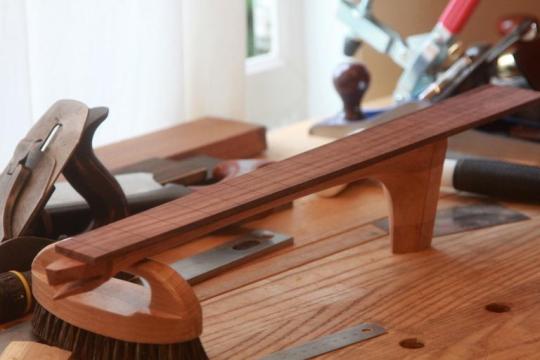 I couldn't believe how much plastic fret marker dots cost. Instead I bought an acrylic pen blank, and whittled out some dots. It's a bit ironic in that they're made in such an assortment of colours and patterns I should choose one that's practically invisible against the fretboard, but it shows that it's doable. 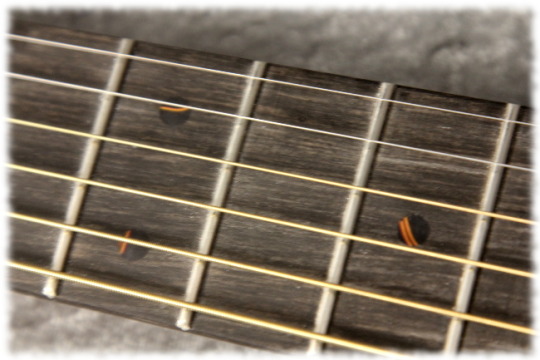 |
|
|
|
Post by mel on Aug 24, 2015 18:33:34 GMT
This is sticking the neck on, going well. 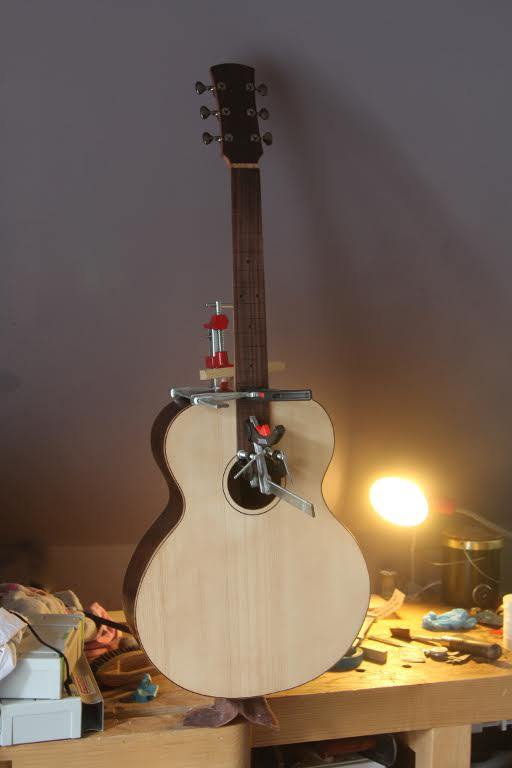 This is an emergency operation from a while ago. The joint froze before being fully seated and no amount of banging could move it. I raced to get my Piher welding clamp with it's huge amount of cranking power to save the day. The finish on this one is water based lacquer with epoxy pore fill. 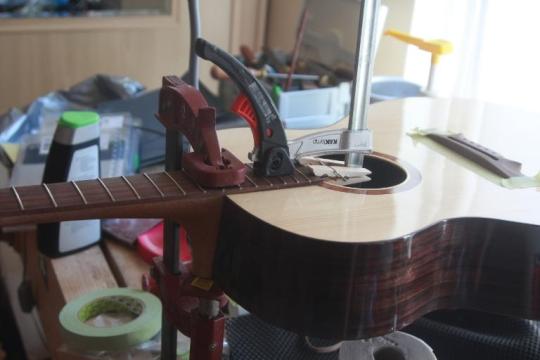 |
|
|
|
Post by mel on Aug 24, 2015 18:46:38 GMT
This one was finished with the neck on. 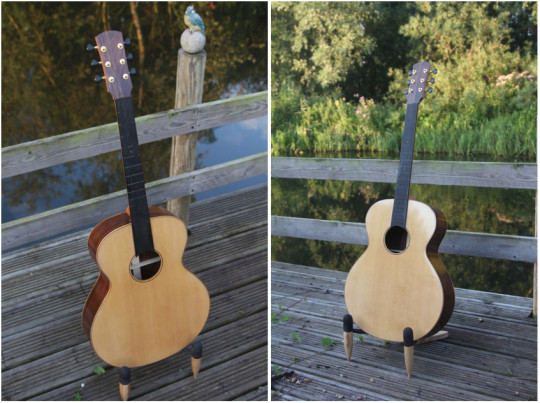 Bridge making seems to be more enjoyable than it looks. The CNC cuts the saddle slot, outline and initial pin holes. I shape it with a block plane, rasp and sandpaper. It's a surprisingly quick job. I ream the pins out and cut slots so I can use solid pins. To get it in the right place there's another plywood jig which references the bridge outline, the fretboard edge and the 20th fret. It's an interference fit on the fretboard. 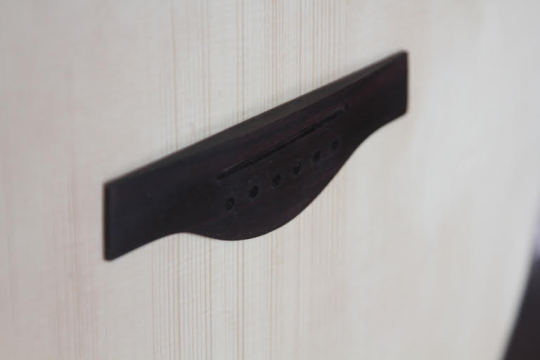 Then after that it's fretted and a nut and saddle is made. I've no pictures of that though. And that's it... 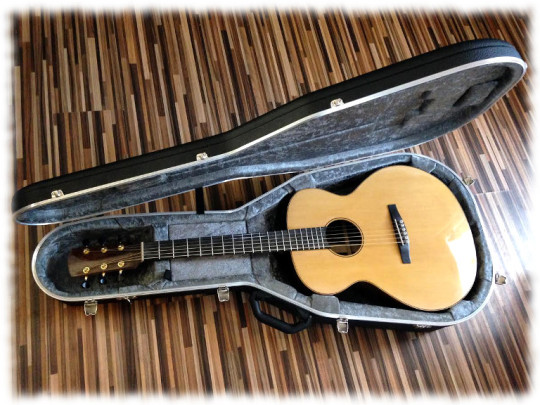 |
|
|
|
New SJ
Aug 24, 2015 19:14:43 GMT
Post by mel on Aug 24, 2015 19:14:43 GMT
Oh that's interesting. Did you find that there are any tonal differences that might be due to the type of finish? Thank you for your kind words. I'm not a pro builder... at the moment. I'm very devoted to this though, I suppose you could say I'm a student. For most of my life I made consumer electronics which have life spans of 5, 10, 15 years. Now that I'm older I feel like making use of my time building something more lasting. Mel. The nitro guitar is a Red Spruce/Mahogany 12 fret 00 steel string, and the FP guitar is a Western Red Cedar/African Padauk flamenco guitar and due to the differences I've got no idea whether FP produces a 'better sounding' guitar than nitro/etc but I absolutely love the feel of the FP neck, the smell is wonderful and a FP finish in the flesh to my eyes anyway is more appealing than a nitro/poly finish (like comparing a unwaxed apple to a waxed one if that makes sense). No idea whether a FP guitar is a better sounding instrument but I'd pick it every time if I could. Keep up the great work with the builds and keep posting photographs of the progress. It's always a pleasure to see build threads here. Are you planning to make any other body sizes aside from the SJ? It'd be nice if the finish does make no difference. Better or worse isn't so much the issue for me, it's whether I'd need one or the other to achieve a particular type of tone. I was chatting with a group of luthiers once (proper ones, not part-timers like me) and they were talking about another chap who wanted to produce a better XYZ guitar. They said the chap was talking a lot about changing to a different style of bracing to make it better and using a betterer type of wood to achieve this. Anyway, what they were saying was that if the chap wanted to make an XYZ guitar he'd be better off using the same type of wood and same type of bracing that XYZ used. It seems to make sense to me, but maybe it doesn't apply as far as the finish. I've a Gibson L mould which I've used before and will probably do again, and I'm likely to start working on an OM fairly soon. Also I've accumulated a lot of nice ukulele wood so I should probably so more of those. |
|
|
|
New SJ
Aug 24, 2015 19:58:15 GMT
Post by earwighoney on Aug 24, 2015 19:58:15 GMT
It'd be nice if the finish does make no difference. Better or worse isn't so much the issue for me, it's whether I'd need one or the other to achieve a particular type of tone. I was chatting with a group of luthiers once (proper ones, not part-timers like me) and they were talking about another chap who wanted to produce a better XYZ guitar. They said the chap was talking a lot about changing to a different style of bracing to make it better and using a betterer type of wood to achieve this. Anyway, what they were saying was that if the chap wanted to make an XYZ guitar he'd be better off using the same type of wood and same type of bracing that XYZ used. It seems to make sense to me, but maybe it doesn't apply as far as the finish. When it comes to finish, here is a quote from Lester DeVoe, (one of the finest flamenco guitar makers around) "Sprayed Lacquer Finish: I have not noticed a difference in tone from French polish. My finish is thinly applied and that is most important. A French polish finish will not make a poorly constructed guitar sound good; but any finish applied too thickly can deaden the sound of a well made guitar." The L Shape is a very interesting one, possibly the most 'Rubenesque' guitar body! It's in the 00/14" side of things, which is my favourite body size for comfort and sound. |
|
|
|
Post by mel on Sept 27, 2015 21:17:04 GMT
What's the building equivalent of GAS? GBS? Another one strung up today. 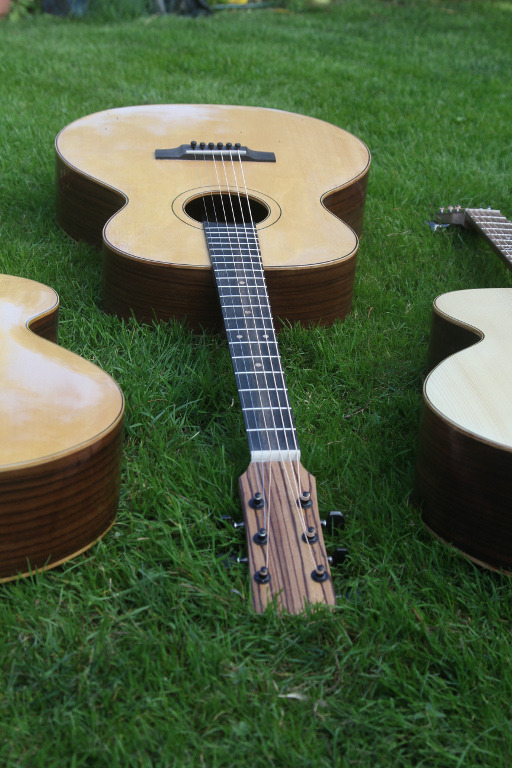 |
|
|
|
Post by mel on Sept 27, 2015 21:19:45 GMT
|
|
leoroberts
C.O.G. 

Posts: 26,142  My main instrument is: probably needing new strings
My main instrument is: probably needing new strings
|
New SJ
Sept 28, 2015 8:21:45 GMT
Post by leoroberts on Sept 28, 2015 8:21:45 GMT
Some beauties there, mel! You going to do a quick recording with one or two of them perhaps?  |
|
|
|
Post by mel on Sept 29, 2015 16:38:49 GMT
Thanks! I've just dusted off my olde recorder.
Mel.
|
|